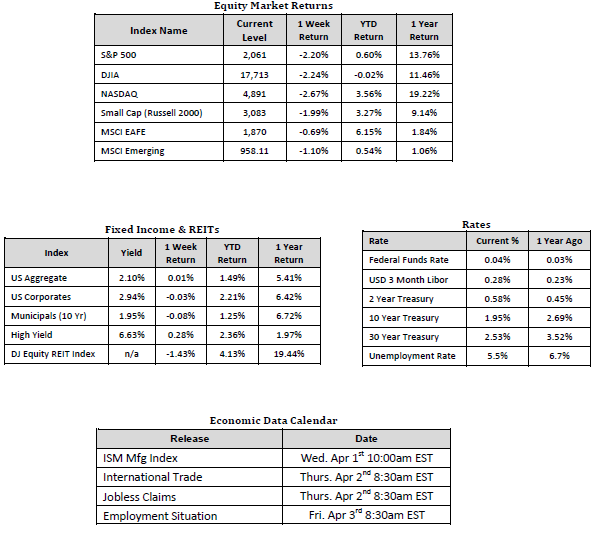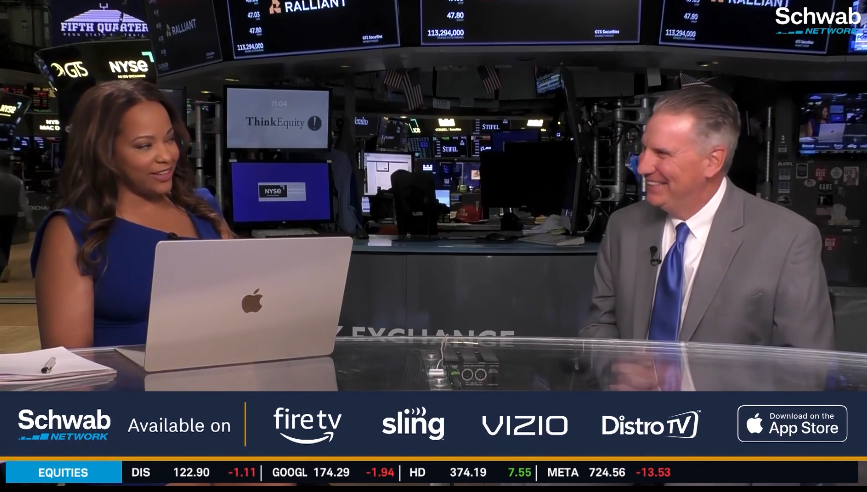
Capital Markets Update – Week of 3/30/2015
Market Overview
Sources: Rates Data and Economic Calendar—Bloomberg Markets as of 3/31/15; Equity Market, Fixed Income and REIT returns from JP Morgan as of 3/27/15.
Happening Now
Central Banks and Cheap Oil Fuel Local Market Returns in Q1
As the first quarter of 2015 comes to a close it is evident that cheap oil and loose monetary policy have helped certain international markets post some of their largest quarterly returns in a decade. As of the close of trading on Monday March 30: the DAX index, which measures the performance of 30 of Germany’s largest companies, has returned over 23% for the quarter; the CAC Index which tracks the 40 largest French companies by market cap has returned 19%; and the price weighted Nikkei 225 index which serves as a proxy for Japan’s equity markets has posted a return of over 11% to start the year. One thing these countries have in common is that they are all net importers of crude oil and benefiting from lower energy prices. They are also reaping the benefits of loose monetary policy and in turn weaker currencies. For U.S. investors, however, access to these markets often carries with it currency risk that must either be hedged or at the very least understood and taken into consideration.
Here in the U.S. equity markets are coming off of their 4th weekly decline in five weeks as the S&P500 fell over 2% for the 5 day period. As of Friday, March 27, the S&P 500 is now up only 0.6% for the year while mid and small Cap stocks, as measured by the S&P 400 Mid Cap and Russell 2000, are up 3.8% and 3.3% respectively. When the economic cycle is expanding mid and small cap stocks, historically, outperform their large cap counterparts. Continuing on this trend, growth stocks have outperformed value stocks in all three market capitalizations with large cap growth returning 3.6%, mid cap growth returning 4.9% and small cap growth returning 5.6% for year.
When investing for growth it is crucial to understand what stage of the economic cycle you find yourself in. Investors savvy enough to overweight mid/small cap and growth oriented stocks in their portfolios have seen significant outperformance relative to the broader markets. Of critical importance, however, is not only to consider an investment’s return potential but the risk that goes along with it.
Important Information and Disclaimers
Past Performance is not a guarantee of future performance.
Investing in foreign securities presents certain risks not associated with domestic investments, such as currency fluctuation, political and economic instability, and different accounting standards. This may result in greater share price volatility. These risks are heightened in emerging markets.
There are special risks associated with an investment in real estate, including credit risk, interest rate fluctuations and the impact of varied economic conditions. Distributions from REIT investments are taxed at the owner’s tax bracket.
The prices of small company and mid cap stocks are generally more volatile than large company stocks. They often involve higher risks because smaller companies may lack the management expertise, financial resources, product diversification and competitive strengths to endure adverse economic conditions.
Investing in commodities is not suitable for all investors. Exposure to the commodities markets may subject an investment to greater share price volatility than an investment in traditional equity or debt securities. Investments in commodities may be affected by changes in overall market movements, commodity index volatility, changes in interest rates or factors affecting a particular industry or commodity.
Products that invest in commodities may employ more complex strategies which may expose investors to additional risks.
Investing in fixed income securities involves certain risks such as market risk if sold prior to maturity and credit risk especially if investing in high yield bonds, which have lower ratings and are subject to greater volatility. All fixed income investments may be worth less than original cost upon redemption or maturity. Bond Prices fluctuate inversely to changes in interest rates. Therefore, a general rise in interest rates can result in the decline of the value of your investment.
Definitions
MSCI- EAFE: The Morgan Stanley Capital International Europe, Australasia and Far East Index, a free float-adjusted market capitalization index that is designed to measure developed-market equity performance, excluding the United States and Canada.
MSCI-Emerging Markets: The Morgan Stanley Capital International Emerging Market Index, is a free float-adjusted market capitalization index that is designed to measure the performance of global emerging markets of about 25 emerging economies.
Russell 3000: The Russell 3000 measures the performance of the 3000 largest US companies based on total market capitalization and represents about 98% of the investible US Equity market.
ML BOFA US Corp Mstr [Merill Lynch US Corporate Master]: The Merrill Lynch Corporate Master Market Index is a statistical composite tracking the performance of the entire US corporate bond market over time.
ML Muni Master [Merill Lynch US Corporate Master]: The Merrill Lynch Municipal Bond Master Index is a broad measure of the municipal fixed income market.
Investors cannot directly purchase any index.
LIBOR, London Interbank Offered Rate, is the rate of interest at which banks offer to lend money to one another in the wholesale money markets in London.
The Dow Jones Industrial Average is an unweighted index of 30 “blue-chip” industrial U.S. stocks.
The S&P Midcap 400 Index is a capitalization-weighted index measuring the performance of the mid-range sector of the U.S. stock market, and represents approximately 7% of the total market value of U.S. equities. Companies in the Index fall between S&P 500 Index and the S&P SmallCap 600 Index in size: between $1-4 billion.
DJ Equity REIT Index represents all publicly traded real estate investment trusts in the Dow Jones U.S. stock universe classified as Equity REITs according to the S&P Dow Jones Indices REIT Industry Classification Hierarchy. These companies are REITSs that primarily own and operate income-producing real estate.




